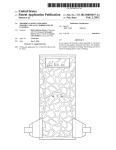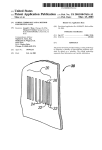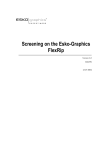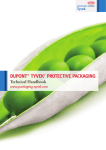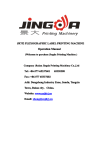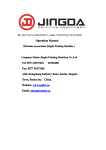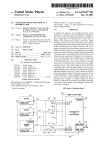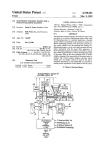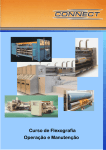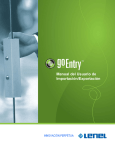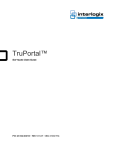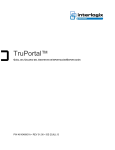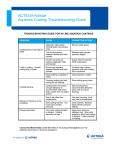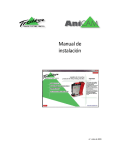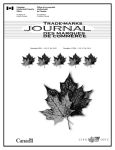Download Method Of Printing Graphics On Absorbent
Transcript
US 20130289511A1 (19) United States (12) Patent Application Publication Warner et al. (54) (10) Pub. N0.: US 2013/0289511 A1 (43) Pub. Date: Oct. 31, 2013 METHOD OF PRINTING GRAPHICS ON ABSORBENT-ARTICLES Publication Classi?cation (51) (76) Inventors: Alrick Vincent Warner, Loveland, OH (US); Timothy Wayne Roberston, Int. Cl. A61F 13/84 (2006.01) (52) US, Cl, Cincinnati, OH (US); Beth Goldman USPC .................................... .. 604/385.01; 101/483 Mason, Cincinnati, OH (US); George Christopher Dobrin, Mason, OH (US); (57) Rachel Eden Walther’ Unlon’ KY (Us) Absorbent articles having graphics disposed upon them and ABSTRACT methods of printing graphics. The graphics are suitable for or (21) APP1~ N05 13/457,562 actually embodied in fabric and may be Visually coordinated (22) to clothing. The clothing may be an article of clothing and/or a line of clothing. Filed: Apr. 27, 2012 1 l ,1.» - m Mun...“ 1/ / m .,/" Patent Application Publication Oct. 31, 2013 Sheet 2 0f 10 %, US 2013/0289511 A1 @ £3E»Eta WM... w 5%gm“a$25ig3n M W W Q, gig£33»“Emmma$@M‘u23» u Patent Application Publication Oct. 31, 2013 Sheet 3 0f 10 US 2013/0289511 A1 (Yam rag (mack) Patent Application Publication Oct. 31, 2013 Sheet 4 0f 10 US 2013/0289511 A1 Patent Application Publication Oct. 31, 2013 Sheet 5 0f 10 Lwltixr: Fix: 4 US 2013/0289511 A1 Patent Application Publication Oct. 31, 2013 Sheet 6 0f 10 US 2013/0289511 A1 Patent Application Publication Oct. 31, 2013 Sheet 7 0f 10 US 2013/0289511 A1 Patent Application Publication Oct. 31, 2013 Sheet 8 0f 10 US 2013/0289511 A1 Patent Application Publication Oct. 31, 2013 Sheet 9 0f 10 US 2013/0289511 A1 Patent Application Publication Oct. 31, 2013 Sheet 10 0f 10 US 2013/0289511 A1 US 2013/0289511A1 METHOD OF PRINTING GRAPHICS ON ABSORBENT-ARTICLES CROSS REFERENCE TO RELATED APPLICATIONS [0001] This application claims the bene?t of US. applica tion Ser. No. 13/156,583, ?led on Jun. 9, 2011; Which claims the bene?t of US. Provisional Application No. 61/368,071, ?led on Jul. 27, 2010; US. application Ser. No. 13/156,954, ?led on Jun. 9, 2011; Which claims the bene?t of US. Provi sional Application No. 61/368,252, ?led on Jul. 27, 2010; and US. application Ser. No. 13/185,543, ?led on Jul. 19, 2011; Which claims the bene?t of US. Provisional Application No. 61/368,255, ?led on Jul. 27, 2010; the substances ofWhich are hereby incorporated by reference. FIELD OF THE INVENTION [0002] In one aspect, the invention relates generally to absorbent articles having graphics disposed upon them and methods of printing graphics. The graphics are suitable for or actually embodied in fabric and may be visually coordinated to clothing. The clothing may be an article of clothing and/or a line of clothing. BACKGROUND OF THE INVENTION [0003] Absorbent articles are used commonly. In many cases, eg diapers, the purchaser of the absorbent article is not the end user of the article. Many factors in?uence the pur chaser’s decision to purchase particular absorbent articles, non-limiting examples of Which include: price and product performance, eg absorbency, ease of fastening/refastening, tactile feel against the skin, etc. The aesthetics of an absorbent article have become an increasingly important factor in driv ing purchase decision-making. Many purchasers prefer to Oct. 31,2013 [0006] It is an obj ect of this invention to provide absorbent articles bearing at least one graphic, and methods of printing and selling the absorbent articles, Wherein at least one visual characteristic of the at least one graphic is visually coordi nated to at least one visual characteristic of an article of clothing and/or a line of clothing. It is an object of this invention to provide absorbent articles bearing at least one graphic, Wherein at least one visual characteristic of the at least one graphic is visually coordinated to at least one visual characteristic of a line of clothing. It is an object of this invention to provide absorbent articles bearing at least one graphic, Wherein at least one visual characteristic of the at least one graphic is visually coordinated to at least one visual characteristic of a particular article of clothing, i.e. not a type of clothing or a genre of clothing. It is an object of this invention to provide a method of printing graphics on absor bent articles Where the graphics comprise designs inspired by designs suitable for or actually embodied in fabric. It is an object of this invention to provide a method of printing With increased detail resolution. It is an object of this invention to provide a method of printing With improved color-to-color register. It is an object of this invention to provide a method of printing With thinner line Weight. These and other objects, features, and advantages of the invention Will become more apparent upon reading the folloWing speci?cation in conjunc tion With the accompanying draWing ?gures. BRIEF DESCRIPTION OF DRAWINGS [0007] FIG. 1A is a ?owchart of a method of printing graph ics on absorbent articles suitable for use With the present invention. [0008] FIG. 1B is a ?owchart of a method of printing graph ics on absorbent articles suitable for use With the present invention. [0009] FIG. 2 is an illustration of three axes (respectively have colors, patterns, and/or other designs employed by the for the L*, a*, and b* value of a given color) used With the absorbent article. This creates a need to provide desirable CIELAB color scale. [0010] FIG. 3 is a perspective vieW of a design embodied in an article of clothing. [0011] FIG. 4 is a perspective vieW of a design created graphics Without having an unacceptably negative impact on other decision factors, such as price and absorbency. [0004] Although absorbent articles bearing graphics are knoWn, these graphics are not designed to be visually coor dinated to a particular article of clothing or to a particular line of clothing. Purchasers increasingly prefer absorbent articles With graphics, and it is believed that some purchasers Would prefer absorbent articles With graphics that have a similar appearance to particular articles of clothing and/or lines of clothing. It is knoWn for an absorbent article to bear a graphic that generically looks like a “type of clothing”, e.g. blue jeans; hoWever, it is not knoWn to coordinate the graphics on an absorbent article to the graphics on actual articles of cloth ing, eg a particularly patterned and/ or colored out?t that is using design softWare, inspired by a creator Who vieWs the graphics embodied in an article of clothing. [0012] FIG. 5 is a perspective vieW of a graphic printed on a diaper that is inspired by the design shoWn in either of FIG. 3 or 4. [0013] FIG. 6 is a perspective vieW of a design embodied in an article of clothing. [0014] FIGS. 7A and 7B are perspective vieWs of graphics printed on diapers that are inspired by the design shoWn in FIG. 6. [0015] FIG. 8 is a perspective vieW of a design embodied in an article of clothing. sold as a clothing item, or a series of related clothing items that constitute a line of clothing, e. g. the Jane Doe collection, sold by a particular retailer. Accordingly, there is a need for such absorbent articles. [0016] FIGS. 9A and 9B are perspective vieWs of graphics printed on diapers that are inspired by the design shoWn in SUMMARY OF THE INVENTION DETAILED DESCRIPTION OF THE INVENTION [0005] In one aspect, the invention relates generally to absorbent articles having graphics disposed upon them and methods of printing graphics. The graphics are suitable for or actually embodied in fabric and may be visually coordinated to clothing. The clothing may be an article of clothing and/or a line of clothing. FIG. 8. [0017] In one aspect, the invention is intended primarily for use With absorbent articles. As used herein, the term “absor bent article” refers to devices Which absorb and contain body exudates, and, more speci?cally, refers to devices Which are placed against or in proximity to the body of the Wearer to absorb and contain the various exudates discharged from the US 2013/0289511A1 body. As used herein, the term “diaper” refers to an absorbent article generally Worn by infants and incontinent persons that is Worn about the loWer torso of the Wearer. It should be Oct. 31,2013 [0021] In an embodiment, an absorbent article appears visually coordinated to an article of clothing, and/or a line of clothing, to a consumer. An absorbent article Will be visually understood, hoWever, that the invention is also applicable to coordinated When one or more its visual characteristics are other absorbent articles such as incontinence briefs, inconti herein, the term “disposable” refers to absorbent articles that matched With the corresponding visual characteristics of the article of clothing, and/or line of clothing. These visual char acteristics may be visible patterns of color. The color of these patterns can be described by the value of the hue, saturation, and luminosity. This color Will be determined from the visible generally are not intended to be laundered or otherWise restored or reused as absorbent articles, i.e. they are intended to be discarded after a single use, and preferably, to be spectral and angular distribution of light coming from an object. The patterns can be described by their location, extent, shape, and orientation. These patterns may have smaller pat recycled, composted, or otherWise disposed of in an environ mentally compatible manner. In an embodiment, the absor bent articles for Which the invention is primarily intended for use, are disposable absorbent articles. [0018] In an embodiment of the invention, the method terns contained Within them. The pattern may be the result of the non-uniform chemical composition of the element like the nence undergarments, incontinence pads, diaper holders and liners, feminine hygiene garments, feminine hygiene pads, feminine hygiene pantiliners, tampons, and the like. As used described herein is used to print one or more graphics for an printing of a pattern of a dye or from the texture of the element like the embossing of a pattern. The pattern Will be deter mined from the visible spatial, spectral and angular distribu tion of light coming from an object. absorbent article. In another embodiment, the graphics match [0022] one or more graphics on a particular article of clothing. In yet another embodiment, the graphics match one or more graph intended to mean a visible, distinguishing or recogniZable As used herein, the term “visual characteristic” is feature or attribute of a visible aspect of one or more elements ics on articles of clothing that comprise a line of clothing. of an absorbent article and/or an article of clothing, and/or a [0019] line of clothing. Non-limiting examples of visual character Absorbent articles may typically comprise a top sheet having a bodyfacing surface and a garment facing sur face, a backsheet having a bodyfacing surface and a garment facing surface, and an absorbent core disposed betWeen the istics are color, texture, pattern, form, and the like. [0023] As used herein, the term “visible” is intended to mean attribute of feature Which is visually perceived by an garment facing surface of the topsheet and the bodyfacing individual user or consumer. Generally for a consumer or surface of the backsheet. In an embodiment, the graphics created by the method disclosed herein are disposed upon the user, the attribute should be visible in the range of about 0.25 bodyfacing surface of the topsheet. In another embodiment, the graphics are disposed upon the garment facing surface of the topsheet. In another embodiment, the graphics are dis posed upon the garment facing surface of the backsheet. In yet another embodiment, the graphics are disposed upon both the bodyfacing surface of the topsheet and the garment facing consumer or non-user, generally for an attribute to be visible, surface of the backsheet. Other absorbent articles, e.g. cata menial tampons, may typically comprise a compressed ab sor bent core disposed Within an overWrap substantially covering the exterior surface of the compressed absorbent core, the overWrap having a core facing surface and a bodyfacing sur face. In an embodiment, the graphics created by the method disclosed herein are disposed upon the core facing surface of the overWrap. In another embodiment, the graphics are dis posed upon the bodyfacing surface of the overWrap. In yet another embodiment, the graphics are disposed upon both the core facing surface of the overWrap and the bodyfacing sur face of the overWrap. In an embodiment, the overWrap com prises a non-Woven material. [0020] In an embodiment, the invention provides a method of selling absorbent articles bearing at least one graphic, Wherein at least one visual characteristic of the at least one graphic is visually coordinated to at least one visual charac teristic of an article of clothing and/or a line of clothing. The graphic and the clothing each has at least a ?rst, and prefer ably additional visual characteristics, Wherein the visual char acteristics of the graphic are matched the corresponding visual characteristics of the clothing. In other embodiments, there are at least 2, preferably at least 3, visual characteristics feet (0.075 meters) to about 3 feet (0.91 meters). For a non the distance Will typically be greater than about 3 feet (0.91 meters). As used herein, “perceived” or “perception” is the ability to recogniZe an attribute or feature When the visual angle that the attribute or feature subtends is greater than about 5 minutes of visual arc and less than about 45 minutes of visual arc as determined by the folloWing equation: Min utes of visual arc:3438*(length of the object/distance from object); Wherein the length of the object:siZe of the object measured perpendicular to the line of sight, the distance from obj ectIdistance from the front of the eye to the object along the line of sight, and a minute of visual arc is 1/60th of 1 degree. [0024] As used herein, the term “color” is intended to mean an individual’s perception of the spectral composition of visible light coming from a portion of an object. Color char acteristics include hue, saturation and luminosity. Each is a separate color characteristic. Hue is the attribute of a color Which alloWs it to be classi?ed as a given color. Saturation, Which is sometimes referred to as vividness, is the intensity of the color. Saturation is the degree of freedom from gray. Luminosity, sometimes referred to as value, is the degree of lightness (paleness) or darkness in a color. For example, a blue With White added is a pale color, e.g. baby blue and blue With black added is a dark color, e.g. navy blue. A measure ment of hue, saturation and luminosity are described in more detail beloW. [0025] As used herein, the term “form” is used to describe an individual’s perception of the spatial variation of visible light due to the bulk shape and structure of a portion of an that are matched. In yet other embodiments, there are at least object in three dimensions. Stated another Way, form is shape 4, preferably at least 5, visual characteristics that are matched. In still other embodiments, there are at least 6, preferably at least 7, visual characteristics that are matched. In yet other embodiments, there are at least 8, preferably at least 9, visual and structure of an item Which distinguishes it from its sur characteristics that are matched. rounding Which causes a spatially discontinuous change in light that is transmitted through or re?ected from an item. [0026] As used herein, the term “texture” is used to describe the individual’ s perception of the spatial variation of US 2013/0289511A1 visible light due to surface structure of a portion of an object in tWo dimensions. Textures can be visual effects generated by surface roughness and visual illusion created by mere color or pattern. Texture may be the result of the natural characteristics of a given material as a result of the material formation process. Textures may also be imparted to a mate rial using techniques knoWn to those skilled in the art includ ing, for example, printing, embossing, bonding, aperturing and the like. [0027] As used herein, the term “pattem” is used to describe the individual’s perception of spatial variation of visible light due to contrasts in spatial variation of light due to the color, form, and texture of a portion of an object incorpo rated into the object by the manufactory of the elements. This contrast creates various visual distinct regions or lines some times referred to as “?gures” Within its surrounding some times referred to as “ground.” Patterns can be formed by combinations of contrasting color, form, and texture relative to its surroundings. An element can have more than one pattern, but each pattern Would be distinguishable, recogniZ able, and separate from the other patterns on the element. Pattern is also a term used to describe the observer’s percep tion of combined effect of more than one color, form, or texture Within a portion of an observer’ s ?eld of vieW. Patterns may have a “length”, “extent”, “shape”, “position” and “ori entation”. Each is a pattern characteristic Within the scope of the present invention. Length is the perceived distance along the major axis of the pattern. The “major axis” is the axis of the longest symmetry. The extent of the pattern is the area of the pattern. Shape is simply the shape of the pattern. Position is the location of the pattern relative to its surroundings. And orientation is position of the major axis of the pattern relative to its surroundings. [0028] As used herein, the term “match” or “matched” is used to describe the Way or degree tWo items visually ?t together. For example, tWo items are considered matched if some aspects of one of the items are identical to similar aspects of another item. In one form of match, tWo items resemble each other are said to match. [0029] As used herein, the term “coordinate” or “coordina tion” is used to describe hoW tWo components or elements of the absorbent article and the article of clothing, and/or line of clothing visually belong together. Visual characteristics are said to coordinate if one aspect of the visual characteristic is the same or falls Within limits described With this speci?ca tion. Visual characteristics are also said to coordinate if they match. Components or elements are considered to be coordi Oct. 31,2013 basis Weight of nonWoven fabrics is usually expressed in ounces of material per square yard (osy) or grams per square meter (gsm) and the ?ber diameters useful are usually expressed in microns. [0031] Coordination may be achieved using certain combi nations of visual characteristics Which unite or harmonize the appearance of an absorbent article With an article of clothing and/or a line of clothing. Coordination may be achieved by matching visual characteristics of the absorbent article and clothing components. As described above, visual character istics are features or characteristics that are discernible by sight during the normal use of the product. Examples of different types of visual characteristics, Which may be employed in the present invention include, Without limitation, color, form, texture, pattern, transmittance/ opacity, gloss, and sheen, among others. [0032] Of the visual characteristics, color is a characteristic that is simple to quantify. Colors have some basic character istics, including hue, saturation, and luminosity. Each of these terms is described above. A given color may be varied by changing the saturation and luminosity. Saturation is changed by adding a neutral color, black, White, or gray. Luminosity may be changed by adding a brightener to a given color. In the present invention, if tWo colors have the same hue, Whether or not they are different in saturation or luminosity, the tWo colors are considered coordinated. Likewise, if tWo colors have the same saturation or the same luminosity, the colors are considered to be coordinated. Colors Which have the same hue, saturation and luminosity are considered matched. Color may be imparted by any means knoW to those skilled in the art, including, for example, printing, dyeing, pigmenting and the like. [0033] Form may be accomplished by techniques knoW to those skilled in the art. Form can be construed on the simplest scale as shape. Shape may be imparted to the components by knoWn methods such as cutting and the like. By using the term “shape” in this context, it is intended that the outline, edges and the like have a shape in addition to a linear outline. Generally, shapes are considered the same if the aspects of one shape are proportional to another shape. For example, in the case of a triangle, if all the angles are identical in tWo different triangles, but the sides are different in length, the tWo triangles are considered to be coordinated since they have the same proportions relative to each other. Stated another Way, shapes are considered to be coordinated if the shapes are the same or are proportional to each other. [0034] Textures can be visual effects generated by rough nated if they match. Graphics are considered to be coordi nated if they match. An absorbent article and an article of clothing are considered to be coordinated if they match. An absorbent article and a line of clothing are considered to be surfaces, and or differences in the surface characteristics, or visual illusions created by mere color or pattern. Texture may be the result of the natural characteristics of a given material coordinated if they match. Colors may be coordinated if they as a result of the material formation process. Textures may have a hue, luminosity or saturation that match Within limits described beloW. [0030] As used herein, the term “nonWoven fabric or Web” also be imparted to a material using knoWn techniques knoWn to those skilled in the art including, for example, printing, means a Web having a structure of individual ?bers or threads Which are interlaid, but not in a regular or identi?able manner as in a knitted or Woven fabric. The term also includes indi vidual ?laments and strands, yarns or toWs as Well as foams [0035] One or more objects, one or more geometric and non-geometric shapes and/or one or more colors having some embossing, bonding, aperturing and the like. relationship With one another may achieve patterns. Patterns and ?lms that have been ?brillated, apertured, or otherWise treated to impart fabric-like properties. NonWoven fabrics or may be random or repeating. Repeating patterns Will typically have objects, shapes, and/or colors in a given frequency or spacing. Patterns can be achieved by repeating a single object, Webs have been formed from many processes such as for or shape or can be achieved by repeating multiple objects or example, meltbloWing processes, spunbonding processes, shapes. Repeating or alternating tWo or more colors With a airlaying processes and bonded carded Web processes. The given frequency may also create patterns. Patterns may be US 2013/0289511A1 Oct. 31,2013 formed by using techniques including, for example, printing, another by having a different hue. One or more colors may embossing, bonding, aperturing and the like. also be different by virtue of having a different luminosity [0036] and/or saturation/vividness. Saturation/vividness is the inten sity of the color from pale to dark. Colors of different hues can be coordinated or match by virtue of having the same lumi Any known printing method may be used so long as a pattern or a texture can be imparted to the surface being printed. Such methods for printing are described brie?y in FIGS. 1A and 1B. [0037] Embossing may be accomplished, for example, by passing a material betWeen a heated or non-heated anvil roll and a heated or non-heated embossing roll, With the emboss ing roll containing a pattern. Other techniques for imparting patterns or texture include, for example, aperturing, creating layers, orientation of materials, bonding patterns and the like. nosity or saturation. For example, pale or pastel colors of different hues tend to blend together or appear that they belong together or are matched due to the fact that the satu ration levels are similar. Other factors in color differences include different ?nishes e.g. gloss/?nish verses a matte ?n ish. Matte ?nishes tend to diffuse or scatter light compared to a gloss ?nish, Which is specular. Texture can also be created by selection of materials having the same or similar visual characteristic, beyond color, and patterns imposed on the material. [0038] In an embodiment, the invention provides a method of selling absorbent articles bearing at least one graphic, [0042] Printing may generally be characterized as an indus trial process in Which an image is reproduced on a substrate, Wherein at least one visual characteristic of the at least one printing, intaglio printing, and electronic printing. Stencil and graphic is visually coordinated to at least one visual charac teristic of an article of clothing and/or a line of clothing. As an screen printing may be used for printing T-shirts, signage, banners, billboards, and the like. Examples of relief printing may include letterpress and ?exography. Examples of plano graphic printing may include offset lithography, screenless lithography, collotype, and Waterless printing. In addition, examples of intaglio printing may include gravure, steel-die, example, a child’s dress has a pattern of purple printed ?oW ers thereon and an element of the absorbent article, for example the backsheet of a diaper, may have the same pattern of purple ?oWers printed thereon. The pattern of ?oWers is a ?rst visual characteristic and the purple hue of the ?oWers is a second visual characteristic. As a result, the absorbent article is coordinated With the article of clothing due to the presence of the pattern of purple ?oWers on both components. Coordination of the product in the present invention is obtained by having one or more visual characteristics that such as paper, polyole?n ?lm, or nonWoven fabric. There are various classes of printing processes, Which may include stencil and screen printing, relief printing, planographic and copper-plate engraving. Examples of electronic printing may include electrostatic, magnetographic, ion or electron deposition, and ink-jet printing. It is it to be appreciated that various types of printing processes may be used to create the graphics disclosed herein. For example, in some embodi ments, it may be preferable to use ?exography. In particular, in terms of at least one visual characteristic, this does not ?exography may utiliZe printing plates made of rubber or plastic With a slightly raised image thereon. The inked plates mean that there cannot be tWo or more visual characteristics are rotated on a cylinder Which transfers the image to the match. While the present speci?cation describes the invention creating the desired coordination affect. In fact, the more substrate. Flexography may be a relatively high-speed print shared visual characteristic there are, the more the items process that uses fast-drying inks. In addition, ?exography appear to be coordinated. In the present invention, there may be tWo, three, four, ?ve, six, seven, eight, nine or more visual can be used to print continuous patterns on many types of absorbent and non-absorbent materials. Other embodiments characteristic Which are coordinated. In one embodiment, may utiliZe gravure printing. More particularly, gravure print there are at least 2, preferably at least 3, more preferably at least 4, visual characteristics that are coordinated. [0039] In an embodiment, a ?rst and second visual charac teristic are different in some aspect from each other. It is possible for the visual characteristics to be tWo different ing utiliZes an image etched on the surface of a metal plate. The etched area is ?lled With ink and the plate is rotated on a colors, a color and a pattern, a texture and a color, a texture ink are jetted from a small aperture directly to a speci?ed position on a media to create an image. TWo examples of and a pattern, tWo different patterns, tWo different textures and the like. If there are three characteristics Which are dif ferent, then there could be tWo different colors and a pattern; three different colors; a color, a pattern and a texture; among many other combinations. [0040] In an embodiment, White is generally not considered as a color is used as the coordinating feature if White is a predominate color on the element being coordinated. This is because White is the predominate color of absorbent articles, cylinder that transfers the image to the substrate. Still other embodiments may utiliZe ink jetprinting. Ink jet is a non impact dot-matrix printing technology in Which droplets of inkjet technologies include thermal bubble or bubble jet and piezoelectric. Thermal bubble uses heat to apply to the ink, While pieZoelectric uses a crystal and an electric charge to apply the ink. [0043] In addition to the aforementioned various types of printing processes, it is to be appreciated that various types of inks or ink systems may be applied to various types of sub strates to create the disclosed patterns, such as solvent-based, HoWever, White may be a coordinating color, provided that it Water-based, and UV-cured inks. The primary difference among the ink systems is the method used for drying or curing is not used as the predominate color on the components or the ink. For example, solvent-based and Water-based inks are surfaces being coordinated. Stated another Way, White may be dried by evaporation, While UV-cured inks are cured by chemical reactions. Inks may also include components, such and thus White does not lend itself as a coordinating color. a coordinating color if it is used as an accent or a non dominate color. By “non-dominate color” it is intended mean a color Which encompasses less than 50%, desirable less that 30%, of the surface area of a surface. [0041] In an embodiment, the ?rst and second visual char acteristics may be con?gured as ?rst and second colors. Each of the ?rst and second colors may be different from one as solvents, colorants, resins, additives, and (for ultraviolet inks only) UV-curing compounds, that are responsible for various functions. [0044] As shoWn in FIG. 1A, a method of printing graphics on absorbent articles 10 is provided. According to method 10, Which comprises one or more of the folloWing steps, a graphic US 2013/0289511A1 is selected, the graphic’s color(s) are determined, the sub strate on Which to print the graphic is selected, the siZe and layout of the graphic are manipulated to make it ?t the area of the absorbent article it is to be printed on, and the graphic is printed on a substrate. These steps and additional optional Oct. 31,2013 Examples of the design being embodied in an article of cloth ing are shoWn in FIGS. 3, 6, and 8. In yet another embodi ment, the graphic is createdusing design softWare, e.g. Adobe Photoshop® or Adobe Illustrator®. In such an embodiment, the design may be created from scratch, or it may be inspired steps are discussed in more detail herein. It is to be noted that, by a creator Who has vieWed the graphics embodied in a it Will be appreciated by the skilled person that in alternate fabric, an article of clothing, a clothing line, artWork, a paint ing, or the like. An example of the design being created using design softWare, inspired by a creator Who has vieWed the embodiments, some steps may be performed in a different order or they may be performed concurrently. [0045] As shoWn in FIG. 1B, a method of printing graphics on absorbent articles is provided. According to the method, graphics embodied in an article of clothing, is shoWn in FIG. 4 Which comprises one or more of the folloWing steps, an inspi [0047] rational theme is selected, available design elements are scanned into a computer ?le, a layout is created (using Adobe process Will typically result in a higher quality print ulti mately being printed. In one embodiment, resolution of the image of the graphic embodied in the ?le Will be at least 150 Creative Suite® or similar software), vector images are cre ated based on the scanned image or scanned images are The use of a higher quality ?le at this point in the dpi (dots per inch). When ?exographic printing is used, pref placed on a template of the absorbent article to be printed on, scanned or draWn images may be stepped and repeated to ?ll the space on a template of the absorbent article to be printed on, artwork is manipulated to add 3-dimensional effects and erably the print siZe of an image to be printed, in pixel dimen sions, Will be 150 times the number of inches. Thus, for example, to ultimately print on an 8"><8" sWatch, the image embodying the graphic Will have a resolution of 1200 pixels>< details, e.g. shadoWs, stitching, pockets, belts, belt loops, 1200 pixels. snaps, button, button holes, and the like, graphics are ren dered as a 3-dimensional image or digitally printed for con sumer testing, a determination is made of consumers’ accep [0048] In an embodiment Where the graphic is a scan of a design, suitable scanners Will typically scan at 2400 dpi reso lution or higher. Suitable scanners include the Epson® tance of the graphics, an editing loop is provided Whereby any Expres sion® IOOOOXL, Which is particularly useful When the desired changes to improve consumer acceptance are made, graphic is embodied in a fabric. [0049] TWo colors are considered coordinated if they have color separation and print suitability adaptations are deter mined and made based on press ?ngerprinting information, ?exographic plates are manufactured, a preliminary printing trial is conducted to check color builds and color match, hand-made absorbent articles are made to con?rm color and layout in the context of the absorbent article, a check is conducted to check the safety, appearance, and market suit ability of the absorbent articles, a check is conducted to check ink adhesion and colorfastness, print trial results are revieWed, a determination is made of Whether the print trials Were successful for the attributes measured, an editing loop is provided Whereby any desired changes to improve success for the attributes measured are made, a commercial print trial is conducted Wherein absorbent articles are shipped to a manu facturing plant for being converted into saleable absorbent articles, a check is conducted to check Whether the printed absorbent articles are suitable for sale, a determination is made of Whether the printed absorbent articles are suitable for sale based on the attributes measured, an editing loop is provided Whereby any desired changes to improve success for the attributes measured are made, the printed absorbent articles suitable for sale are offered for sale. These steps and additional optional steps are discussed in more detail herein. It is to be noted that, it Will be appreciated by the skilled person that in alternate embodiments, some steps may be performed in a different order or they may be performed ?rst and second hues that are the same. Colors of different hues are also considered coordinated if they have a value (luminosity) difference of less than 5% of maximum, alter natively less than 3% of maximum or alternatively less than 1% of maximum. Colors of different hues are also considered coordinated if they have a saturation difference of less than 5% of maximum, alternatively less than 3% of maximum or alternatively less than 2.5% of maximum. [0050] In an embodiment, color matching of visible sur faces is determined by the color of an absorbent article and the corresponding color of the clothing and/or line of clothing having a speci?ed CIELab color space hue difference (AH). Characterizing color matching by the hue difference is desir able in that hue difference accounts for and considers all three dimensions Within CIELab. While not being limited to this theory, such a three-dimensional measurement is believed to more fully characteriZe the difference in tWo colors. [0051] CIELAB is a conventional color model used to describe colors visible to the human eye. FIG. 2 is an illus tration of three axes (respectively for the L*, a*, and b* value of a given color) used With the CIELAB color scale. When a color is de?ned according to the CIELAB color scale, L* represents lightness (OIblack, 100qvhite), a* and b* inde concurrently. pendently each represent a tWo color axis, a* representing a red/green axis (+a:red, —a:green), While b* represents a [0046] In selecting a graphic, the graphic may comprise one or more designs inspired by designs suitable for or actually yelloW/blue axis (+b?/elloW, —b:blue). The maximum for L* is 100, Which represents a perfect re?ecting diffuser, and the embodied in fabric. The graphic may be embodied in an electronic ?le. Suitable ?le formats are JPG, J PEG, PNG, GIF, TIF (e.g. 8-bit, uncompressed). Preferably, the ?le Will be less than 30 megabytes in siZe. The source of the graphic may vary. In certain embodiments of the invention, the design may be embodied in a fabric, an article of clothing, a clothing line, artWork, a painting, or the like. In any of the aforemen tioned embodiments, the graphic may be reduced in the form of a digital photograph, or in the form of an electronic scan. minimum for L* is Zero, Which represents black. The a* and b* axes have no speci?c numerical limits. The CIELAB color scale is an approximate uniform color scale, Wherein the differences betWeen points plotted in the color space corre spond to visual differences betWeen the colors plotted. Based on the L*, a*, and b* values for a ?rst color (i.e. L1, a1, bl) and a second color (i.e. L2, a2, b2), the difference betWeen the colors (i.e. AE) can be calculatedusing the folloWing formula: US 2013/0289511A1 [0052] wherein, [0053] [0054] [0055] Ab*:bl—b2. [0056] The L*a*b* values for each Zone of color in the graphic may be determined in various ways. For example, the L*a*b* values of the color Zones may be determined by using ink with relatively known L*a*b* values. Alternatively, the L*a*b* values in a Zone can be determined from the elec tronic ?le that is generated when a pattern is created. In such Oct. 31,2013 embodiment, it is to be printed on the ear of a diaper. In an embodiment, the substrate has a basis weight of less than or equal to 20 gsm. [0061] In an embodiment, the substrate has a low modulus, i.e. s20 Newtons/cm. In another embodiment, the modulus of the substrate is from 16 to 20 N/ cm. In another embodiment, the modulus is 516 N/cm. Applicants have learned that high winding speeds of 1000 feet per minute or more, along with various ?lm properties, can impart defects into the wound layers of ?lm during winding. For example, non-uniform a case, the L*a*b* values may be obtained with a computer equipped with a software that can provide the L*a*b * value of tensions and/ or pressures are oftentimes imparted to the ?lm a selected area. A non-limiting example of such software may the core of the roll) due to various factors such as tension be Adobe Photoshop®. In another embodiment, the L*a*b* values of various color Zones on a graphic can be measured directly from the printed substrate that bears the design inspir ing the graphic. A suitable procedure for measuring the L*a*b* values of a color Zone is provided below. [0057] In an embodiment, color measurements are per formed using a commercial ?atbed scanner capable of 4800 dpi, at 16 bit color depth, such as an Epson Perfection V500 Photo scanner (Epson America, Long Beach, Calif.). Each scan is calibrated against Pantone standards, and measure ments made using Adobe Photoshop CS3 Extended Edition (Adobe Systems, Inc, San Jose, Calif.). The sample is mea sured on the printed side of the substrate. For example, if a laminate consist of a nonwoven and a ?lm where the printing is on the ?lm and sandwiched between the ?lm and non woven, the nonwoven is removed before the printing on the ?lm is measured. [0058] Scans are calibrated using the Pantone Process Col ors standard from the Pantone Formula GuideiUncoated Papers (Pantone, Carlstadt, N.J.). CIE L*a*b* values are measured for the Pantone standard for each color, i.e., Process Yellow U, Process Magenta U, Process Cyan U, Process Black U, and the White uncoated paper. Tristimulus colors are measured according to ASTM Method E1164-07 (Standard Practice for Obtaining Spectrophotometric Data for Object Color Evaluation) using a Hunter Labscan XE (HunterLab, Reston, Va.) with HunterLab Universal Software vs. 4.10 with the following settings: Scale CIELAB, 0/45 StdMode, Area View 0.50 in., Port SiZe 0.70 in., UV ?lter Nominal During measurement the standard is backed using the white calibration plate provided by HunterLab. To increase the reli ability of the measurement, each color should be measured at during winding (e.g., at the outermost wound layers and near variations in the winding device (e.g., tolerance run-outs in the winding cylinder), ?lm stability at the winding device, caliper control of the ?lm, etc. The resulting unevenness between the two wound layers (e.g., the outermost wound layer and an immediately underlying wound layer) can pro duce a wound-in defect(s) that later “grows” as multiple suc cessive windings layers of the ?lm are wound on top of the defect(s). These winding-induced defects can include: varia tions in print repeat length, tin can-type defects (e. g., the ?lm roll exhibits a series of raised annular bands so as to resemble the side of a tin can), and gauge band types of defects. In this regard, while efforts are made to precisely design and build the mechanical components of the winding device, for large ?lm width winding applications (e. g., on the order of 1 meter, 1 .5 meters or even 2 meters or greater), unavoidable precision runouts tend to produce non-uniform tension during winding; in instances where the affected ?lm layer is unable to readily move (or relax) relative to the immediately underlying layer (e.g., due to friction), one or more of the winding-induced defects mentioned above can occur. Winding defects are typi cally more frequently observed when the ?lm is thin, has a low basis weight, and/or has a low modulus. In an embodi ment, the ?lm is has a thickness of 51 mm; preferably it is 50.75 mm. In an embodiment, the ?lm has a basis weight of 520 gsm; preferably 516 gsm. In an embodiment, the ?lm has a modulus of 520 N/cm; preferably about 16 N/cm. In an embodiment, the ?lm is has a thickness of 51 mm, a basis weight of 520 gsm, and a modulus of 520 N/cm. In yet another embodiment, the ?lm is has a thickness of 50.75 mm, a basis weight of 516 gsm, and a modulus of 16 N/cm. [0062] The siZe and layout of the graphic are manipulated least in triplicate and averaged. The sample is placed on the to make it ?t the area of the absorbent article it is to be printed scanner with the printed-side toward the sensor. The Pantone standard is also placed on the scanner such that the sample and standard are both captured in the same image. [0059] The scan is collected at 1200 dpi at 8 bit color depth printed, e. g. the diaper backsheet, by any suitable process that obtains the desired color and shape of the graphic for the into Photoshop for objects with a primary dimension of greater than 3 mm, and at 2400 dpi, 8 bit color depth for objects with a primary dimension of less than 3 mm. Within Photoshop, the image is transformed into a Lab, 8 bit image (note in this version of Photoshop, L*a*b* is imprecisely denoted as Lab). Using the “Levels” command, the L channel of the image is adjusted to read within 2 units for each of the yellow, magenta, cyan, black and white colors on the Pantone standard. L*a*b* values are measured using the Color Sam pler Tool using an 11 by 11 average sample siZe. [0060] The graphic may be selected to be printed on a suitable area for printing on any surface suitable for printing on the absorbent article. In an embodiment, the graphic is to be printed on the backsheet of an absorbent article. In another on. The graphic can be centered on a template of the area to be given print area. In an embodiment, a designer alters the siZe or dimensions of the graphic to ?t the area of the absorbent article substrate to be printed on. This typically involves cropping, enlarging/ decreasing the overall dimensions of the graphic, and may involve modifying the graphic itself by introducing or removing design features of the graphic in order to make it ?t the print area. Care should be taken not to modify the graphic in a way that causes too much detail to be lost. [0063] The difference between the colors (i.e. AE) can be used to compare the colors graphic being printed versus tar get, e. g. when conducting test prints. In one embodiment, the AE between the graphic being printed and the original design is less than 16. In another embodiment, the AE between the graphic being printed and the original design is less than 12. US 2013/0289511A1 In yet another embodiment, the AE betWeen the graphic being printed and the original design is less than 9. Oct. 31,2013 (0.112"). In an embodiment, the thickness of the plate is 1.70 shoWn in either of FIG. 3 or 4. FIGS. 7A and 7B shoW a mm (0.067") With a relief of 0.020 inch. In another embodi ment, the thickness of the plate is 1.70 mm (0.067") With a relief of 0.025 inch. [0069] The anilox and doctor blade meter an even amount graphics printed on diapers that Were inspired by the design of ink to the printing plate. The ink is held in the billions of shoWn in FIG. 6. FIGS. 9A and 9B shoW graphics printed on anilox cells While the doctor blade runs over the surface of the anilox removing any excess ink. The anilox is typically manu [0064] The graphic is printed on a substrate. FIG. 5 shows a graphic printed on a diaper that Was inspired by the design diapers that Were inspired by the design shoWn in FIG. 8. [0065] Optionally, one or more test prints are done. Settings may be adjusted, e.g. color, siZe, and/ or shape, after each successive test print until the desired color and appearance of the graphic are obtained. One factor to consider in adjusting settings is to compare the colors and density of the graphic being printed versus target. Colors may be printed by using a variety of methods. Some suitable methods are single spot factured from a ceramic compound Who se hardness provides long life and is resistant to abrasion from the doctor blade. The anilox roll is manufactured to release a certain ink Weight from the laser engraved cells, so the siZe of the cells and resolution are important to the color on the ?nal printed image. [0070] There are tWo main types of ink supply and doctor color; 4-color process printing (using cyan, magenta, yelloW, ing system used in ?exography. In open systems the anilox and black; also knoWn as “CMYK”); expanded color gamut 6-color or 7-color (CMYK+orange, green, and violet; also rotates in an open bath of ink and the doctor blade meters the knoWn as “OGV”); or a combination of 4-color, 6 color, or 7 ink just prior to the ink being transferred to the plate cylinder. [0071] The Chamber system encloses the ink using tWo color process printing With spot color printing. In an embodi ment, 7 color process printing is combined With spot color printing. Additional factors to consider in adjusting settings are the shape and layout of the graphic. This may also include color-to-color alignment. Yet another factor to consider in adjusting settings is ink adhesion, eg how Well it resists blades Within a chamber. The retaining blade at the bottom acts as a seal While the doctorblade at the top performs the ink rub-off and/or leaching. [0066] In an embodiment, the graphic is printed using a system is contained. [0072] In an embodiment, the ?exographic printing press metering. The ink is pumped through the system to maintain ing a constant supply of ink to the anilox surface. Advanta geously, the closed doctoring system requires less ink to “charge” the system and there is no release of VOC’s, as the ?exographic press. The ?exographic generally operates by comprises from 2 to 10 stations. These include but are not transferring ink from a soft rubber transfer roller to an anilox roll; this roll is ?lled With billions of tiny cells. Once they are limited to three main con?gurations, the central impression ?lled, a doctor blade is used to scrape aWay any excess ink from the surface of the roller; this meters the quantity of ink to reach the printing plate. Ink is spread evenly on the anilox rollers to transfer ink to the raised parts of the ?exible printing plate. The printing plate is Wrapped around a plate cylinder. The raised sections of a ?exographic printing plate are coated With ink ready to be pressed on the material to be printed. An impression cylinder presses the substrate (?lm) to be printed against the printing plate. The raised sections of the printing plate transfer their ink coating to the material being printed. press, the in-line press, and the stack press. [0073] A Web passes around the central impression (CI) cylinder With each color being printed in turn. Inter-station driers are used to cure the inks betWeen print stations to ensure Wet on dry printing. An advantage of this type of press is that registration is excellent, as the Web is held over the CI drum betWeen print stations. There is less chance of the sub strate being extended betWeen the print stations. The press speed of central impression presses can generally be increased beyond that of the other press types. The ink is dried. Each ink color requires its oWn anilox inking rollers, plate and cylinder, and colors are printed one after the [0074] The in line press is a combination of individual units With a small distance betWeen the print heads. Each color is printed on the Web fed substrate. Each color has an individual other on to the material as it passes through the press. impression cylinder against Which the plate is pressed. An [0067] advantage of the in line press is that other printing technolo gies (such as rotary screen or gravure) and additional colors/ In an embodiment, the ?exographic press has a color-to-color registration accuracy of 10.04 mm. Such a press is the ASTRAFLEX®, available from Windmoeller & processes can be incorporated by simply adding another sta Hoelscher Corp. Accordingly, by using a ?exographic press tion. These machines often use UV inks Which are dried With such accuracy in color-to-color registration, graphics betWeen each print station. may be printed having very narroW lines as ?ne as 50.032 inch [0075] When using ?exographic printing, certain manage in Width, preferably 0.020 inch. Also suitable are ?exographic ment of the surface energy of print tools and substrates and the surface tension of the inks can lead to unexpected results. The presses knoWn as the NOVOFLEX® and VISTAFLEX® (both available from W&H). surface tension/energy of the components of the printing pro [0068] cess are advantageously arranged such that it increases from the inks, to anilox, to plates, to substrates. In one embodi Suitable printing plates are typically made from one or more photopolymers and are typically supplied in ?at sheets of un-reacted polymer. They are then processed by specialist pre-press houses. The use of a higher quality plate at this point in the process Will typically result in a higher ment, the difference in surface tension/energy betWeen the inks and the substrates is from 10 to 14 dynes, preferably 12 dynes/ cm. quality print ultimately being printed. Raised areas of the [0076] A design Will typically comprise various design ele plate transfer the ink. In an embodiment, the relief is up to and including 0.8 mm in height. In an embodiment, the total thickness of the plate is from 1.3 to 1.7 mm, preferably 1.5 mm. In various embodiments, the thickness of the plate is ments of the absorbent article. Design elements may be physi line, location of tabs, fasteners, borders, junctions of materials, stitching, and like elements. Design elements may selected from 1.14 mm (0.045"), 1.70 mm (0.067"), 2.28 mm (0.090"), 2.54 mm (0.100"), 2.72 mm (0.107"), and 2.84 mm or elements that are not actual physical features but are to be cal features of the absorbent article, such as the overall out also be either actual physical features of the absorbent article US 2013/0289511A1 printed on the absorbent article to make it appear that they are Oct. 31,2013 taining the imparted color to be analyzed should be selected. actual elements of the absorbent article, non-limiting Typically, sample points are selected so as to be close in examples of features that may fall Within either or both of these groups include: printing borders, seams, pockets, zip perceived color. A single ply of the element is placed over the spectrophotometer’ s sample port. A single ply, as used Within pers, zipper ?aps, topstitching, embossment, quilting, but tons, boWs, ribbons, straps, snaps, belt loops, suspenders, the test method, means that the visible surface of the element is not folded. Thus, a single ply of a visible surface may sales tags, etc. [0077] A design may also be themed or exhibit an otherWise like group of colors and patterns and/or solid prints. In an include the sampling of a laminate, Which itself is comprised of more than one lamina. The sample point comprising the color to be analyzed must be larger than the sample port to embodiment, they may be selected from groups being catego rized as being gender neutral, boy appropriate, or girl appro priate. In another embodiment, they may be selected from groups categorized as being sporty, outdoors, sophisticated, the manufacturer, is placed behind the visible surface. The L*, a*, and b* values are read and recorded. The visible professional, casual, cute, sassy, feminine (e.g. quilted, pais ley, curly cues, polka dots), fresh, seasonal (e.g. spring, sum mer, fall, Winter), patriotic, Weather/ climatic (e.g. sunny, rainy, snoWy), ethnic, soft tones, earth tones, pastels, rock ’n roll, Western (e.g. coWboy/coWgirl), animal, plant, food, or industrial. [0078] The hue difference represents the distance betWeen tWo points Within CIELab color space. The CIELab color ensure accurate measurements. A White tile, as supplied by surface is removed and repositioned so that a minimum of six readings are obtained for the visible surface. If possible (e. g., the size of the imparted color on the element in question does not limit the ability to have six discretely different, non overlapping sample points), each of the readings is to be performed at a substantially different region on the visible surface so that no tWo sample points overlap. If the size of the imparted color region requires overlapping of sample points, only six samples should be taken With the sample points space hue difference (AH) for a ?rst color (L*l, a*l, b*1) and a second color (L*2, a*2, b*2), is calculated according to the selected to minimize overlap betWeen any tWo sample points. The readings are averaged to yield the reported L*, a*, and b* folloWing formula: AHIV (AE)2—(AC)2—(AL*)2. Within said values for a speci?ed color on a visible surface of an element. formula, AE is the CIELab color space total color difference betWeen the tWo colors and is calculated as presented above. The AC is the CIELab color space chroma difference betWeen the tWo colors and is calculated by: [0081] Coordination in the present invention may also con tain commonly used color schemes Which tend to harmonize or coordinate. That is, the ?rst and second visual color char acteristics may be selected to enhance the visual coordination in addition to having at least a ?rst and second color as the ?rst and second visual characteristics. Examples of these color schemes include, for example, monochromatic color, complementary colors, analogous colors, Warm and cool col ors, neutral colors, color contrast, tetradic color scheme, triad The AL* is the difference in L* values betWeen the tWo colors and is calculated by: AL*:L*2—L*1. [0079] In an embodiment, at least tWo visible surfaces each comprising an imparted color Will have a CIELab color space hue difference of 54 in order to be considered matching. In another embodiment, the difference Will be 53. In yet another embodiment, the difference Will be 52. The visible surfaces are analyzed according to the Test Method described beloW. Upon analysis, the inherent color of an element comprising a visible surface Will yield L*, a*, and b* coordinates. TWo elements are selected and the L*, a*, and b* values of the elements are inserted into the formula presented above to result in a hue difference. [0080] Visible surfaces are tested in a dry state and at an ambient humidity of approximately 50%:2%. Re?ectance color scheme or other chord color schemes. Monochromatic color scheme uses one base color but varies the color tint, shade and/or tone. Complementary colors are colors Which are opposite each other on a color Wheel. Analogous colors are colors Which are adjacent each other on the color Wheel. Warm and cool color schemes use three colors, tWo of Which are Warm colors and one is cool color or tWo cool colors and one Warm color. Warm colors are generally associated With ?re and the sun, for example, red, yelloW and orange and cool colors are generally associated With Water the sky and foliage, for example green, blue and violet. Neutral color coordina tion includes using shades of black, White, gray and beige together. Color contrast scheme include using dark and light colors together. Tetradic is a four color scheme and a triad color scheme is a three color scheme, both of Which are knoWn to those skilled in the art. Any of these color schemes color is measured using the Hunter Lab LabScan XE re?ec tance spectrophotometer obtained from Hunter Associates Laboratory of Reston, Va. The spectrophotometer is set to the may be used in the present invention to help coordinate and CIELab color scale and With a D50 illumination. The Observer is set at 10° and the Mode is set at 45/0°. Area VieW is set to 0.125" and Port Size is set to 0.20" for ?lms; Area VieW is set to 1.00" and Port Size is set to 1.20" fornonWovens the present invention. [0082] Coordination may be created by providing a theme on the absorbent article that matches the theme embodied in and other materials. The spectrophotometer is calibrated prior to sample analysis utilizing the black and White reference tiles supplied from the vendor With the instrument. Calibration is examples of themes include: sporty, outdoors, sophisticated, professional, casual, cute, sassy, feminine (e.g. quilted, pais ley, curly cues, polka dots), fresh, seasonal (e.g. spring, sum mer, fall, Winter), patriotic, Weather/ climatic (e.g. sunny, rainy, snoWy), ethnic, soft tones, earth tones, pastels, rock ’n roll, Western (e.g. coWboy/coWgirl), animal, plant, food, or done according to the manufacturer’s instructions as set forth in LabScan XE User’s Manual, Manual Version 1.1, August 2001, A60-1010-862. If cleaning is required of the reference tiles or samples, only tissues that do not contain embossing, lotion, or brighteners should be used (e.g., Puffs® tissue). Any sample point on the visible surface of the element con harmonize tWo or more colors as the visual characteristics in an article of clothing and/or line of clothing. Non-limiting industrial. [0083] TWo patterns are considered coordinated When they have substantially the same pattern elements, regardless of US 2013/0289511Al other factors such as orientation. To gain a better understand ing of hoW patterns are considered to be coordinated Within the scope of the present invention, reference is made to FIGS. 3 to 5. In FIG. 3, an article of clothing, a child’s sleeper, is shoWn. Certain visual characteristics exhibited on the sleeper include the giraffe spots, the pattern of giraffe spots, and the color (depicted by gray shading). In FIG. 4, a print out of a graphic design ?le shoWing the graphic being developed for printing on an absorbent article, is shoWn. The graphic design ?le shoWs giraffe spots as the sleeper, the same pattern of giraffe spots as the sleeper, and the same color (depicted by gray shading) as the sleeper, With the addition of a visual characteristic of four giraffes that appear to be standing or Walking. FIG. 5, an absorbent article, a diaper With a graphic printed on it, is shoWn. The diaper shoWs giraffe spots as does the sleeper, a portion of the same pattern of giraffe spots as the sleeper, and the same color (depicted by gray shading) as the sleeper, and the additional visual characteristic of giraffes that appear to be standing or Walking as does the graphic design ?le. These several visual characteristics are coordinated, e.g., substantially the same shape, even though they are of differ ent siZes, and the graphic design ?le and printed diaper share a common visual characteristic that is not shared by the origi nal sleeper. Summarily, referring to FIGS. 3 to 5, elements of the clothing article, a sleeper is con?gured With a shape, the giraffe spots, a pattern, the particular arrangement of giraffe spots, and a certain color of spots, While the absorbent article, a printed diaper, is con?gured With a coordinated shape of giraffe spots, coordinated pattern of arranged giraffe spots, coordinated color, and a further visual characteristic that is similar to the previous elements, depictions of giraffes. The clothing and the absorbent article are coordinated, even though they are of different siZes and notWithstanding that an additional elements, the giraffes, are also present on the printed diaper. Stated another Way, in the present invention, clothing and an absorbent article are considered coordinated if they have the same or similar visual characteristics, Whether the visual characteristics are matched identically or similarly matched. It is further noted that patterns are considered coor dinated if there are pattern elements Which are the same or similar, even if additional pattern elements are present. [0084] In one embodiment, there are at least tWo different types of visual characteristics. One particular combination is the use of color and pattern. As set forth above, the more shared visual characteristics there are, the more coordinated the absorbent article and article of clothing and/or line of clothing Will appear. Oct. 31,2013 stantially the same shape, even though they are of different siZes, and printed diapers have a visual characteristic that is not shared With the original sWeater. Summarily, referring to FIGS. 6, 7A, and 7B, elements of the clothing article, a sWeater, is con?gured With a animal character (an oWl), a coordinating color (White), a pattern (the ?oWer pattern on the oWl’s Wings), the color of the oWl’s body (depicted by gray shading), and a texture (the oWl being embroidered), While the absorbent article (a printed diaper) is con?gured With a coordinated animal character (an oWl), a coordinated coordi nating color (White), a coordinated pattern (the ?oWer pattern on the oWl’s Wings), a coordinated color of the oWl’s body (depicted by gray shading), and a coordinated texture (the oWl being embroidered), and further visual characteristic that are similar to the previous elements, substantially similar ?oWer pattern being printed on the fasteners of the diaper (in FIG. 7A) or of a branch upon Which the oWl appears to be sitting. The clothing and the absorbent article are coordinated, even though they are of different siZes and notWithstanding that an additional elements, the ?oWer pattern and the branch, are also present on the printed diaper. [0086] In order to obtain a better understanding of the present invention, attention is directed to FIGS. 8, 9A, and 9B. In FIG. 8, an article ofclothing, a child’s dress, is shoWn. Certain visual characteristics exhibited on the dress include a monkey, a boW on the monkey’ s ear, the color of the monkey’ s body, having light colored paWs (depicted by gray shading), the monkey being embroidered, and the torso, arms, and legs of the monkey being dotted. In FIGS. 9A and 9B, diapers With graphics printed on them, are shoWn. The diapers shoW a monkey as does the dress, a boW on the monkey’s ear, the color of the monkey’s body, having light colored paWs (de picted by gray shading), the monkey being embroidered, and the torso, arms, and legs of the monkey being dotted, and the additional visual characteristics of the monkey appearing to be partially inserted into a pocket (in FIG. 9A). These several visual characteristics are coordinated, e.g., substantially the same shape, even though they are of different siZes, and one of the printed diapers has a visual characteristic that is not shared With the original dress, and in fact, both of the printed diapers have a different background color than the original dress. Summarily, referring to FIGS. 8, 9A, and 9B, a clothing article, a dress, is con?gured With an animal character (a monkey), a pattern (boW on the monkey’s ear), color (the color of the monkey’s body, having light colored paWs (de picted by gray shading)), texture (the monkey being embroi In order to obtain a better understanding of the dered), and another pattern (the torso, arms, and legs of the present invention, attention is directed to FIGS. 6, 7A, and monkey being dotted), While the absorbent article (a printed 7B. In FIG. 6, an article of clothing, a child’s sWeater, is shoWn. Certain visual characteristics exhibited on the sWeater include an oWl, White as a coordinating color, a ?oWer pattern diaper) is con?gured With a coordinated animal character (a monkey), a coordinated pattern (boW on the monkey’s ear), a [0085] on the oWl’s Wings, the color of the oWl’s body (depicted by gray shading), and the oWl being embroidered. In FIGS. 7A and 7B, diapers With graphics printed on them, are shoWn. coordinated color (the color of the monkey’s body, having light colored paWs (depicted by gray shading)), a coordinated texture (the monkey being embroidered), and another coor dinated pattern (the torso, arms, and legs of the monkey being The diapers shoWs an oWl as does the sWeater, White as a dotted)), and further visual characteristic that are similar to coordinating color, a substantially similar ?oWer pattern on the previous elements, the monkey appearing to be partially the oWl’s Wings as the sWeater, the same color of the oWl’s inserted into a pocket (in FIG. 9A) and both of the printed diapers having a different background color than the original dress (FIGS. 9A and 9B). The clothing and the absorbent body (depicted by gray shading) as the sWeater, the oWl having an embroidered appearance, and the additional visual characteristics of a substantially similar ?oWer pattern being printed on the fasteners of the diaper (in FIG. 7A) or of a branch upon Which the oWl appears to be sitting (in FIG. 7B). article are coordinated, even though they are of different siZes These several visual characteristics are coordinated, e. g., sub diaper. and notWithstanding that an additional elements, the pocket and the different background color, are present on the printed






















